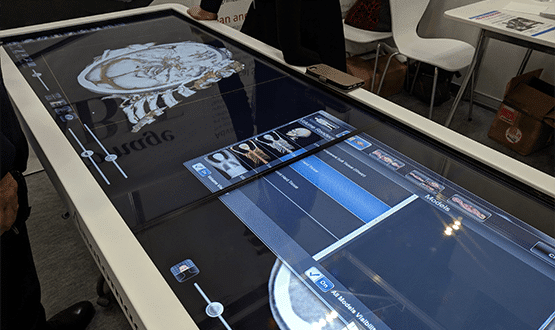Putting on the glitz
- 7 October 2010
 There have been so many, so well publicised problems with the National Programme for IT in the NHS that it is easy to forget that Britain is still seen as a leader in healthcare technology.
There have been so many, so well publicised problems with the National Programme for IT in the NHS that it is easy to forget that Britain is still seen as a leader in healthcare technology.
Clay van Doren, president of global health for BT, reminded his audience of this when he opened the awards ceremony for the E-Health Insider Awards 2010 in association with BT.
“If you look around the world, they look at us as a benchmark, which means we are here to celebrate the best of the best,” he said, before issuing a rallying cry for informatics to help the health service with the challenges it now faces.
“I have every confidence that we will hit that £20 billion efficiency [saving that the NHS has been asked to make over the next four years] by doing all the things we know we can do.”
The first winner of the night, Avon IM&T Consortium, said in its entry for ‘healthcare IT team of the year’ that “delivery” was its “mantra”. Jason Wallace, head of IT services, said: “We were formed three years ago and since then we have worked with clinicians to give them the services they require.
“The quote from one of our provider services is that we are ‘the best in the west’.” Mary Hutton, director of finance and performance at NHS North Somerset agreed. “They have changed the culture,” she said. “Five years ago, our clinicians would not have known what to do with a health IT service. Now they are making new demands all the time.”
Safety and mobile technology
Comedian and awards presenter Marcus Brigstocke joked that the people in the hall at the Grand Connaught Rooms in central London could have worked on glamorous games, such as Grand Theft Auto. “Instead, you spend your time working out how to tell people in Wigan that somebody in Preston’s piles have got better.”
The next award, ‘best use of IT to promote patient safety’, showed that NHS IT innovation is slightly more important than that.
It went to Central Manchester NHS Foundation Trust for a bedside observation and alerting system – Patientrack – that calculates early warning scores for acutely ill patients and alerts staff if their condition deteriorates.
Sarah Ingleby, the lead nurse of the acute care team at the trust, said: “It is fantastic to have won. It is really great. But the really good thing is that we have made a difference to patients.”
Next up was the award for ‘best use of mobile technology in healthcare’, which went to the Scottish Ambulance Service for a cab-based terminal that automatically transmits information to receiving clinicians at accident and emergency departments.
The judges commented that what was truly outstanding about the system was that it works across the entire fleet of 600 emergency vehicles and right across Scotland. They went on to give the project the overall award.
“Eight years ago, I drew a circle and put one word in the middle of it, and that word was patient,” said Robin Lawrenson, clinical performance manager for the Scottish Ambulance Service. “This just shows you what you can do if you put the patient at the heart of things.”
He and his colleague, Roslyn Scott, were almost overcome. “We almost didn’t come tonight and then we won the mobile award, and we had not got over when they announced we had won the overall award,” Lawrenson said. “That was just astonishing. There are 3m users of the Scottish Ambulance Service and this is really for them.”
Involved patients, innovative products
Back at the black tie dinner, the ‘best use of IT in patient and citizen involvement’ went to University Hospital Aintree NHS Foundation Trust for a system that captures patient concerns before treatment.
Physiotherapist Barry Scott said: “The system uses a touch screen to identify patient concerns, which might be about quality of life or financial issues. The idea is that they can then discuss them with a clinician and have a better, more focused consultation as a result.”
The ‘healthcare IT product innovation’ category produced two winners: EMIS Web from EMIS and the Biodose total medication management system from Protomed.
EMIS Web is the ‘next generation system’ from GP supplier EMIS. Biodose helps carers and patients in nursing homes manage their medications more effectively.
Oliver Bocking from the company joked: “We never thought we would win. We thought it would be EMIS Web. We’ve seen EMIS Web and we think it’s great.” To which Carole Davis from EMIS joked: “Thanks”, before adding that the company was delighted with its award which was “the culmination of five years’ work by a lot of people.”
Another system to collect data won the ‘excellence in healthcare information management’ category. Nursing Metrics, developed by Heart of England NHS Foundation Trust, lets nurses collect information to benchmark the care they are delivering.
Jo Richmond, corporate nurse, said: “Nursing Metrics lets us measure some key aspects of performance, and because of IT we can do that in real time. That creates a competitive atmosphere – a good competitive atmosphere – in which wards want to show how well they are doing.”
Major projects
One of the new categories for 2010 was ‘excellence in major healthcare IT development’, which produced another joint winner. The UK NHS Haemophilia Informatics Strategy, Medical Data Solutions and Services shared the award with the London and Southern Programme for IT.
The haemophilia strategy for the NHS Haemophilia Service incorporates four, integrated IT projects: Haemtrack, a national, web-based home treatment records, HCIS, a trust-based management system, NHD, a national registry, and UKHIS, a web-based reporting portal.
Dr Rob Hollingsworth, who has led the project, echoed the opening themes of the evening, when he said: “We are most proud of the fact that this has been a team effort, and that it has delivered something that means patients’ lives have been transformed. It is also saving the NHS £20m a year.”
The London and Southern Programme for IT won for its implementation of RiO at 34 community and 14 mental health trusts.
Richard Caves, chief information officer of NHS South West, said he was most proud of delivering 18 deployments in the South on time, and ready to start helping services to cope with the challenges – including the financial challenges – ahead.
And he commended all those involved, from RiO developer CSE Healthcare, to BT whose “programme management was really first class” to the Southern trusts who were keen to get the new system. “It shows that when you have a product and a project like this, you do not need “ruthless standardisation” to push it through,” he said.
Telehealth and interoperability
The final two awards were for ‘the best use of telehealth and telecare’ and ‘innovation in healthcare interoperability’.
The first went to NHS East of England, for a project to deliver 24/7 thrombolysis to stroke patients. The system uses video and audio to link A&E departments to stroke consultations, speeding up diagnosis and treatment.
“Delivering this service without IT would be impossible because of our geography and our road network,” said Diana Page from the project. “It has made a big difference and we are delighted to have won.”
The second award went to the Department of Health, NHS Connecting for Health and Burbank Health Systems for an Image Exchange Portal that allows medical images to be shared between organisations electronically, based on international standards.
Philip Webster, the DH’s imaging lead, said: “Today, 1,400 patients will benefit from this, because their images will have been where they were needed, and one third of those patients will have been seen as emergencies. Tomorrow, another 1,400 patients will benefit.”
Although Webster said he and his team were “very pleased to have won”, like so many others he clearly felt this was more important.
IT champion of the year
With drinks being handed around and the dancing about to start, one last award was made to the ‘healthcare IT champion of the year’, a special category decided by readers of eHealth Insider and its sister websites. The award this year went to John Thornbury, ICT director of Worcestershire Acute Hospitals NHS Trust.
He also paid tribute to his team, and to the point of the work they did. “I am very pleased to have won, but this is really an award for my team; for all the people behind me,” he said.
“I do not think I have done anything different to lots of other IT people. It is all about working hard to support patient care. So this is an award for everybody involved in healthcare IT.”




